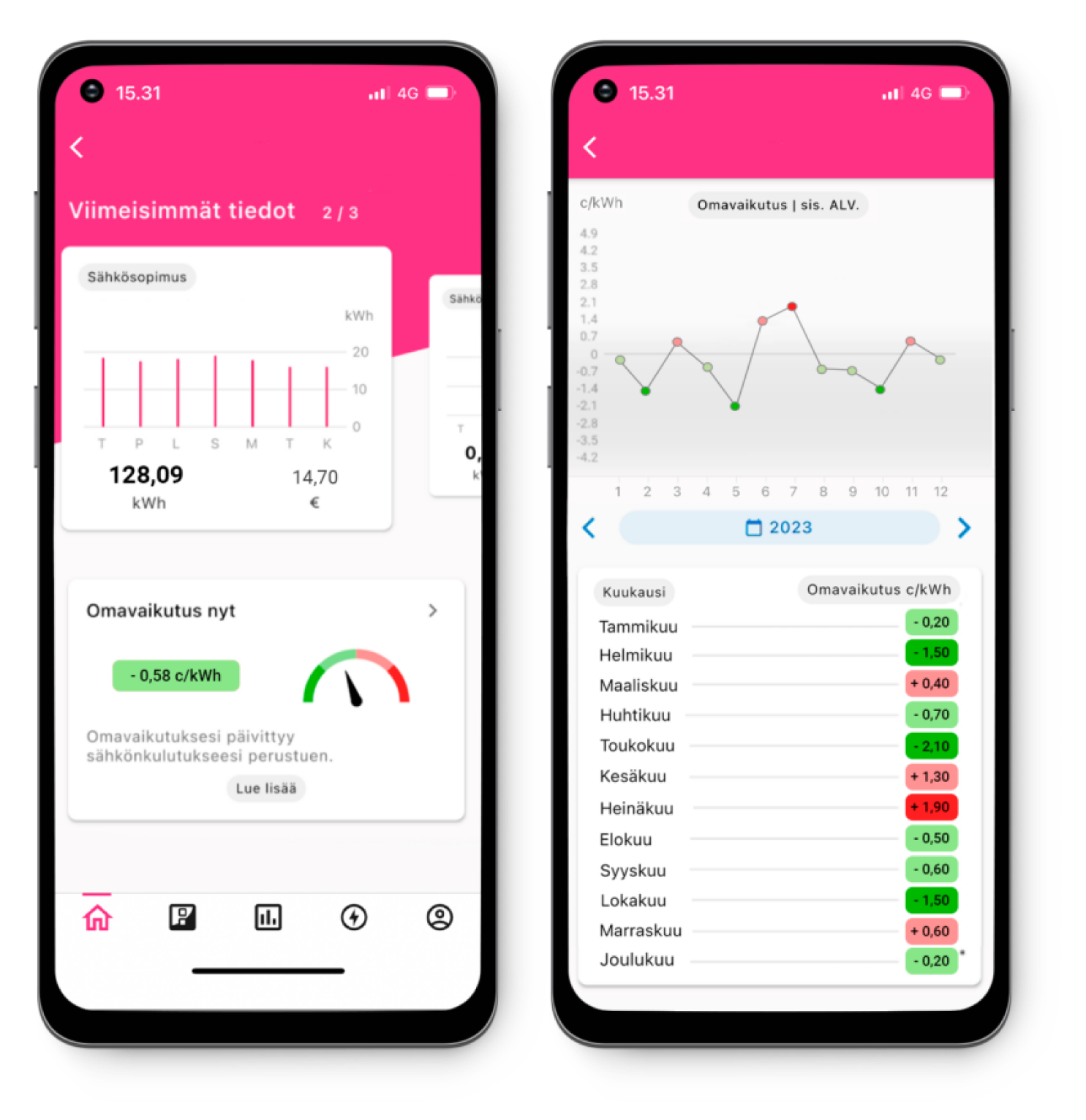
Energy saving tips for households
Reducing your electricity consumption can bring significant savings on electricity while mitigating the carbon footprint of your home. By following a few simple tips, you can optimize your home’s energy consumption easily and effectively. This page gives you information and the most important tips and instructions for saving energy and money.
What home appliances guzzle electricity?
Do you know which of your household appliances use the most energy?
Usually, electric heating, water heaters and electric saunas have the largest impact on your home’s electricity consumption, which is why using them in a conscious and optimized way can have a surprisingly significant impact on your electricity bill.
The appliances using the largest amount of energy are those that are on all the time or require a great deal of power in a short period of time. For example, refrigeration equipment, such as refrigerators and freezers, is kept running around the clock.
In addition to large equipment, smaller household appliances, such as washing machines and dishwashers, and consumer electronics may increase your electricity consumption significantly if they are in active use.
Vaasan Sähkö’s mobile app tells your electricity consumption
You can follow your home’s energy consumption with Vaasan Sähkö’s mobile application and adjust your actions accordingly. On the application, you can view your electricity consumption even by the hour, if you wish.
If you have an exchange electricity contract, you can simply save energy by using electricity when the spot price of electricity is cheap (usually in the evening and at night) and reducing your electricity consumption when the price is more expensive (usually during the day).

Largest energy consumers – heating, hot water and cooling
Heating and the use of hot water have a significant impact on electricity consumption, particularly if the home is heated with electricity. If your home is heated directly with electricity, you should check the room temperatures. Each degree reduced can bring significant savings, on average about 5% per degree. You can keep the room temperature at around 20–22 degrees Celsius – and even lower in rooms that are used less frequently.
Optimizing underfloor heating
It is also advisable to optimize the use of underfloor heating, as it may consume a great deal of electricity if it is set to a high temperature. Here are a few tips for ensuring that the underfloor heating provides heat for your home without being at an unnecessarily high setting.
- Make sure that the floor is not covered with any heat-insulation material, such as a dense or thick rug. If your home is heated by underfloor heating, choose rugs that are thin or made of a material that will allow the heat to pass through.
- Make sure that the windows and doors are adequately insulated, so that the heat provided by the floor does not leak out. If there is a draft in your home, the first thing you should always check is that the insulation is in order.
- If you have an exchange electricity contract, you can preset the underfloor heating to warm the home during times when the price of electricity is at its lowest, e.g., in the evening and at night.
Optimal temperature of domestic water
It is also worth adjusting the temperature of domestic hot water. The recommended temperature for the water heater is around 55–60 degrees Celsius. Do not set it to a lower heat level than that, since it will increase the risk of being exposed to bacteria. You can also save energy by equipping your shower with a thermostatic mixer and spending less time in the shower.
Cooling the home in the summer
Cooling your home in the summer, for example with an air-source heat pump, can increase electricity consumption, but the proper use of such cooling is still more energy efficient than other cooling methods. Often a decrease of one or two degrees in the home will bring relief to the conditions of a hot summer day. An easy way to keep the sun, and excess heat, out is to close curtains or blinds. Remember to close windows and doors if you turn on the cooling.
3 energy-saving tips for households
1.
Heat smartly
In an electrically heated home, the greatest savings can be achieved by regulating the temperature smartly. Lowering room temperature and, if you have an exchange electricity contract, timing the heating for the cheapest hours of the day can bring significant savings, particularly during colder winter months. Also check the insulation in your home and close the curtains for the night to reduce heat loss.
2.
Savings in the sauna and bathroom
In Finland, electric saunas are very important, but they can also consume a great deal of electricity. However, savings can be gained by timing the sauna bathing for the more affordable hours and going to the sauna fewer times a week. The same goes for the water heater and the underfloor heating in the bathroom. If you have an Exchange or Influencer electricity contract, you should time their use for the period when electricity is at its cheapest.
3.
Do household appliances consume a great deal of energy?
Modern appliances are energy-efficient, but their use can still be optimized. Only machine-wash dishes and clothing in full loads and avoid unnecessary washing. When it comes to electricity consumption, it is important to time the use of appliances for when the price of electricity is at its lowest. Nowadays, many dishwashers and washing machines include a timing function.
How does the darker season affect the electricity consumption of Finnish households?
In Finland, the long and dark winters also have an impact on the electricity consumption of homes. Lamps are used much more in the fall and winter, because there is so little daylight.
During the darkest months, the use of indoor and outdoor lighting often increases the energy consumption of households. Moreover, in homes that are heated with electricity, heating accounts for the largest share of energy used, as they require electricity to stay warm during the colder months.
A good way to reduce energy consumption from lighting is replacing all light bulbs with energy-efficient LED bulbs that consume much less electricity than traditional bulbs.
Furthermore, equipping outdoor lamps with timers and motion sensors can also help save energy.
Impact of household appliances on electricity consumption
Household appliances have developed significantly in terms of electricity consumption. Today’s energy-labeled appliances only use a fraction of the electricity that appliances used before energy labels were introduced.
However, since homes have become larger, the need for heating has also increased. Homes are also better equipped, and appliances are used more than ever before.
Although this increases energy consumption, the improved energy efficiency of appliances offsets the increase.
Distribution of and trends in electricity consumption
Even though the number of appliances and level of equipment has increased, the overall energy consumption of Finnish households has decreased in recent years. This is due partly to the improved energy efficiency of appliances and partly to improved energy self-sufficiency enabled by new energy technologies, such as solar panels.
Exchange electricity contracts have also become more common, helping consumers to time their energy use for more affordable hours. This increases energy efficiency and helps reduce consumption when electricity prices and demand are at their highest.
Key takeaways:
- Heating water and your home is the largest energy consumer in a household, and optimizing heating can significantly impact energy consumption.
- Modern appliances are energy-efficient, but using washing machines during periods of low electricity prices is still recommended.
- Similarly, saunas and bathroom floor heating often consume significant amounts of electricity, so it’s worth timing sauna use wisely.
- During the summer, proper use of air source heat pumps can lead to significant savings on your electricity bill.
Order electricity from vaasan sähkö
All of our electricity contracts are produced responsibly and emission free.